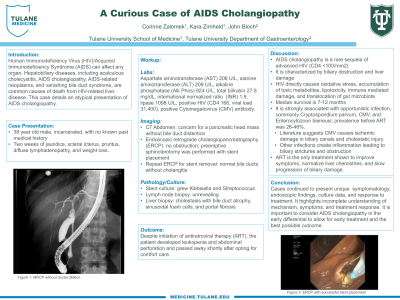Sunday Poster Session
Category: Biliary/Pancreas
P0097 - A Curious Case of AIDS Cholangiopathy
Sunday, October 27, 2024
3:30 PM - 7:00 PM ET
Location: Exhibit Hall E

- CZ
Corinne Zalomek, MD
Tulane School of Medicine
New Orleans, LA
Presenting Author(s)
Corinne Zalomek, MD, Kara Zirnheld, MD, RD, John M. Bloch, MD
Tulane School of Medicine, New Orleans, LA
Introduction: Human Immunodeficiency Virus (HIV)/Acquired Immunodeficiency Syndrome (AIDS) can affect any organ. Hepatobiliary diseases, including acalculous cholecystitis, AIDS cholangiopathy, AIDS-related neoplasms, and vanishing bile duct syndrome, are common causes of death from HIV-related liver disease. This case details an atypical presentation of AIDS cholangiopathy.
Case Description/Methods: A 38 year old male with no medical history presented for two weeks of jaundice, scleral icterus, pruritus, lymphadenopathy, and weight loss. Notable labs include aspartate aminotransferase 206 U/L, alanine aminotransferase 209 U/L, alkaline phosphatase 924 U/L, total bilirubin 27.8 mg/dL, international normalized ratio 1.9, lipase 1098 U/L, positive HIV (CD4 166, viral load 31,400), positive Cytomegalovirus (CMV) antibody.
Abdominal computed tomography showed concern for a pancreatic head mass without bile duct distention. Endoscopic retrograde cholangiopancreatography (ERCP) showed no obstruction; sphincterotomy was performed with stent placement. Lymph node biopsy was unrevealing. Repeat ERCP for stent removal showed normal bile ducts without cholangitis; stent culture grew Klebsiella and Streptococcus. Liver biopsy demonstrated cholestasis with bile duct atrophy, sinusoidal foam cells, and portal fibrosis.
Despite initiation of antiretroviral therapy (ART), the patient developed leukopenia and abdominal perforation and passed away shortly after opting for comfort care.
Discussion: AIDS cholangiopathy is a rare sequela of advanced HIV (CD4 < 100/mm2), characterized by biliary obstruction and liver damage. HIV directly causes oxidative stress, accumulation of toxic metabolites, lipotoxicity, immune mediated damage, and translocation of gut microbiota. Median survival is 7-12 months. Prevalence before ART was 26-46%, suggesting association with opportunistic infection, commonly Cryptosporidium parvum, CMV, and Enterocytozoon bieneusi. Literature suggests CMV causes ischemic damage in biliary canals and cholestatic injury; other infections create inflammation leading to biliary strictures and obstruction. ART is the only treatment shown to improve symptoms, normalize liver chemistries, and slow progression of biliary damage.
This case presents unique symptomatology, endoscopic findings, culture data, and response to treatment. It highlights incomplete understanding of mechanism, symptoms, and treatment response. It is important to consider AIDS cholangiopathy for early treatment and the best possible outcome.
Disclosures:
Corinne Zalomek, MD, Kara Zirnheld, MD, RD, John M. Bloch, MD. P0097 - A Curious Case of AIDS Cholangiopathy, ACG 2024 Annual Scientific Meeting Abstracts. Philadelphia, PA: American College of Gastroenterology.
Tulane School of Medicine, New Orleans, LA
Introduction: Human Immunodeficiency Virus (HIV)/Acquired Immunodeficiency Syndrome (AIDS) can affect any organ. Hepatobiliary diseases, including acalculous cholecystitis, AIDS cholangiopathy, AIDS-related neoplasms, and vanishing bile duct syndrome, are common causes of death from HIV-related liver disease. This case details an atypical presentation of AIDS cholangiopathy.
Case Description/Methods: A 38 year old male with no medical history presented for two weeks of jaundice, scleral icterus, pruritus, lymphadenopathy, and weight loss. Notable labs include aspartate aminotransferase 206 U/L, alanine aminotransferase 209 U/L, alkaline phosphatase 924 U/L, total bilirubin 27.8 mg/dL, international normalized ratio 1.9, lipase 1098 U/L, positive HIV (CD4 166, viral load 31,400), positive Cytomegalovirus (CMV) antibody.
Abdominal computed tomography showed concern for a pancreatic head mass without bile duct distention. Endoscopic retrograde cholangiopancreatography (ERCP) showed no obstruction; sphincterotomy was performed with stent placement. Lymph node biopsy was unrevealing. Repeat ERCP for stent removal showed normal bile ducts without cholangitis; stent culture grew Klebsiella and Streptococcus. Liver biopsy demonstrated cholestasis with bile duct atrophy, sinusoidal foam cells, and portal fibrosis.
Despite initiation of antiretroviral therapy (ART), the patient developed leukopenia and abdominal perforation and passed away shortly after opting for comfort care.
Discussion: AIDS cholangiopathy is a rare sequela of advanced HIV (CD4 < 100/mm2), characterized by biliary obstruction and liver damage. HIV directly causes oxidative stress, accumulation of toxic metabolites, lipotoxicity, immune mediated damage, and translocation of gut microbiota. Median survival is 7-12 months. Prevalence before ART was 26-46%, suggesting association with opportunistic infection, commonly Cryptosporidium parvum, CMV, and Enterocytozoon bieneusi. Literature suggests CMV causes ischemic damage in biliary canals and cholestatic injury; other infections create inflammation leading to biliary strictures and obstruction. ART is the only treatment shown to improve symptoms, normalize liver chemistries, and slow progression of biliary damage.
This case presents unique symptomatology, endoscopic findings, culture data, and response to treatment. It highlights incomplete understanding of mechanism, symptoms, and treatment response. It is important to consider AIDS cholangiopathy for early treatment and the best possible outcome.
Disclosures:
Corinne Zalomek indicated no relevant financial relationships.
Kara Zirnheld indicated no relevant financial relationships.
John Bloch indicated no relevant financial relationships.
Corinne Zalomek, MD, Kara Zirnheld, MD, RD, John M. Bloch, MD. P0097 - A Curious Case of AIDS Cholangiopathy, ACG 2024 Annual Scientific Meeting Abstracts. Philadelphia, PA: American College of Gastroenterology.
